Using a saddle that suits you can mean the difference between having an enjoyable bike ride and having a miserable one. Saddle choices are very subjective, and there is no clear definition of which sizes are best for which people. A multitude of factors come into play including your body mechanics, riding style and positions, and duration of rides, among others. There are also options for different materials for the various parts of a saddle. Most important of all is a personal preference.
The first thing you should know is that sitting properly on a bike seat means staying off soft tissue and instead of having your weight on the ischial tuberosities and pubic rami, aka the sit bones. This is more comfortable as it prevents compression of nerves and blood flow restriction. After considering everything and purchasing the perfect saddle, there are some steps that you should follow which will further improve your experience.
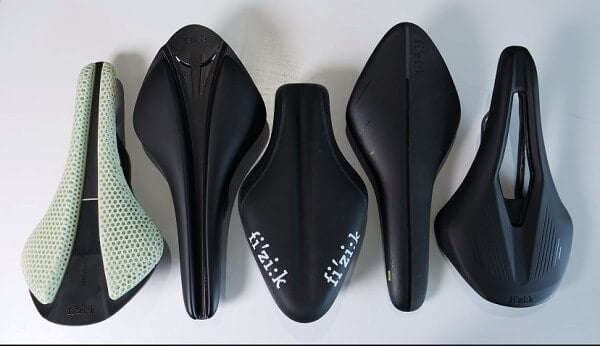
Image: Various saddles
Saddle Size Chart
The main dimension you should be looking at when buying a saddle is the width (MTB seat width guide). You must get an appropriate width. This is mostly determined by the spacing between your sit bones. Keep scrolling to find out how to measure your sit bone width. Meanwhile, the following chart will give you an idea of the approximate saddle width that’s right for you.
| Sit bone width range (mm) | Recommended saddle width range (mm) (According to riding position) | ||
|---|---|---|---|
| Upright | Moderate | Aggressive | |
| 70 – 90 | 125 – 140 | 120 – 130 | 120 – 130 |
| 90 – 110 | 135 – 150 | 125 – 140 | 125 – 140 |
| 110 – 130 | 145 – 160 | 135 – 150 | 135 – 150 |
| > 130 | > 160 | > 150 | > 150 |
How to find the perfect saddle
1. Saddle type according to the cycling discipline
First and foremost, you have to consider what kind of cycling you do. Road cyclists, mountain bikers, and commuters will all have different requirements. Saddles for road use, touring, and commuting are generally long and narrow with some, but not a lot of padding. This is perfect since these forms of riding involve long periods of time on the bike. There is such a thing as too much padding. Racing or triathlon bikes will have similar seats but with almost no padding at all. They are also made of expensive lightweight materials.
➥ Long-distance rides need special saddles. Our team has tested and reviewed some saddles for completing a successful long ride.
Mountain bike saddles need to be sturdy and have a durable cover since they are prone to impacts and scratches. More padding is also used to act like suspension on bumpy terrain. You will find the softest saddles on bikes for urban or casual use. The seats have plush padding, are much wider, and have short noses. This is ideal for short riding times on a bike.
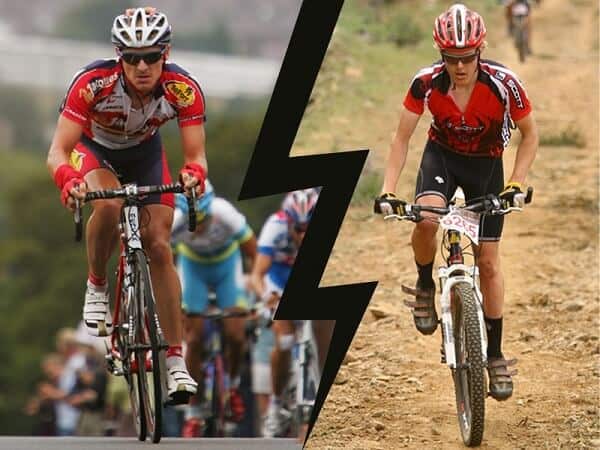
Image: Road and mountain biking | Image Source: bikeradar.com
2. The width of your sit bones
The width of a saddle should closely correlate to the width of your sit bones. Without proper support, you risk damaging soft tissue and causing long-term saddle soreness. You’ll be able to tell if you’re sitting on your sit bones immediately. First, you should measure your sit bone width. Most bike shops have facilities to measure this, such as gel pads that can give an accurate value by you sitting on them. If not, then don’t worry. There is a way do it yourself at home by following these steps:-
- Take some corrugated cardboard and cut out a piece the size of a chair seat. Place this on a chair.
- Sit on it and keep your upper body in a slight forward lean. Be sure to press down hard. Wait a few seconds and stand up.
- There should be two indentations on the cardboard. Measure the distance between the centers of those indentations using a measuring tape. And there you have it!
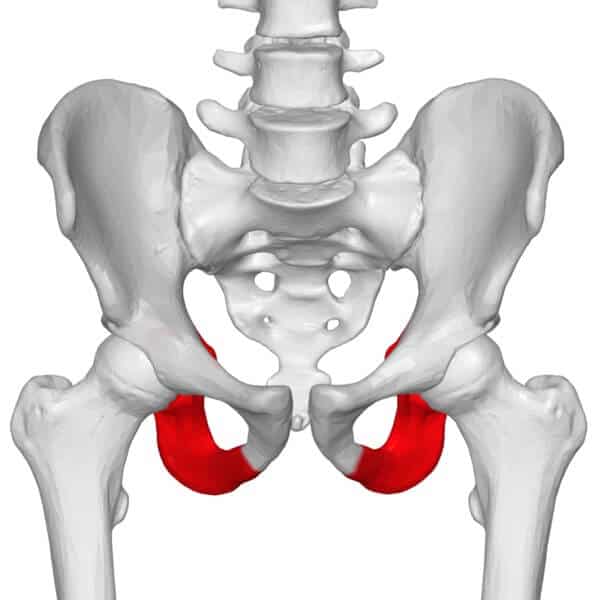
Image: Sit bone width | Image Source: commons.wikimedia.org
Keep in mind that women typically have a wider sit bones width. After you are equipped with this value, you can start trying out different saddles within a certain range of widths according to the table we have provided above. Remember, this is just a starting point and no one can prescribe a size for you.
3. Your body position on the bike
The position you assume when cycling also plays a major role in determining the right saddle. The average rider will be in an upright position most of the time, while a racer will be in an aerodynamic/aggressive lean. As you lean forward the pelvis rolls forward and your weight shifts from the ischial tuberosities to the pubic rami. These have less width, thereby requiring a narrower seat. In short, a more front-end position requires a more curved saddle from front to back, while a more upright position is benefitted from flat saddles.
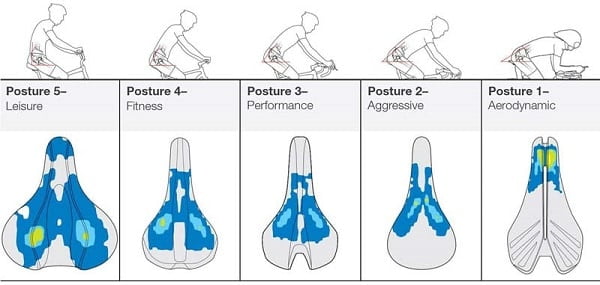
Image: Sitting positions | Image Source: bikerumor.com
4. Build materials
Finally, you can start to think about what you want your saddle to be made out of. The three main parts of a saddle are the shell, padding, cover, and rails. The shell is the main structure of a saddle. It is typically made out of high-density resin. Carbon fiber shells are also available which are lighter but more expensive. Padding is almost always made of polyurethane foam of different densities to determine softness.
The cover could be synthetic or made of more expensive natural leather. There is also the option of slick or coarse covers. If you are, say, a mountain biker, and need to move around on the saddle, use a slick material. For time-trialists, a coarse cover will help to keep you in place. Rails are the part that attaches to the seat post. They are made of steel, Chromoly alloy, titanium, or carbon. Steel and Chromoly are cheaper while titanium and carbon are lighter and costlier.
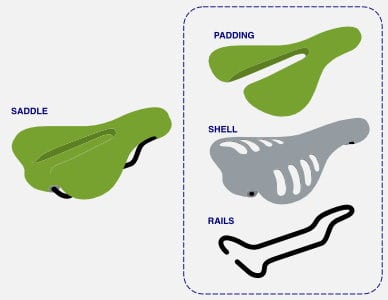
Image: Saddle parts
Tips for ensuring a comfortable ride
1. Sit squarely on the saddle
Always remember to keep your pelvis as symmetrical as possible on the seat. The square sitting position allows your legs to work with equal effort and prevents torque effects on the spine. If you don’t this can lead to chronic pain in the lower back and muscle imbalances in your body. A good sitting position can only be achieved if your sit bones are properly supported.
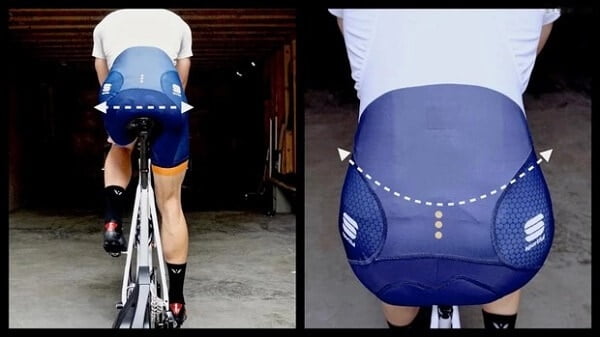
Image: Square sitting position | Image Source: bikeradar.com
2. Adjust the position of the handlebars
Your choice of the saddle should be based on your choice of handlebars and not the other way around. The position of the handlebars can vary a lot based on flexibility, neck and shoulder mobility, and riding style. Whatever the case, your neck, shoulders, and back should be comfortable.
➥ Read our guide on this topic: Correct Height for Bike Seat & Handlebars.
3. Accordingly adjust the saddle height and position
Now you can fine-tune the position of the saddle. This includes the fore-aft position and height. The height should set so that your legs can pedal with maximum efficiency. If the saddle is too far backward or forward, you’ll face discomfort in your arms, neck, and back. Moreover, you should ensure that the saddle is perfectly horizontal or else there could be pain in undesirable areas.
4. Extra features or additions (if required)
There are other features that you could look for to enhance your riding experience. Most notable is the groove or cut-out. A lot of riders swear that this is an essential feature to have since it relieves pressure from the softer regions. Although, we believe this is more of a personal inclination and not everyone needs the extra spacing. You may also choose to buy a saddle pad for extra comfort if needed. Some racing saddles may even not have a nose. Other add-ons include Kevlar reinforcement, plastic bumpers, etc.
➥ For perfect saddle fit, you can read this guide: Bike Saddle Fit Guide: 6 Images will Make the Differences.
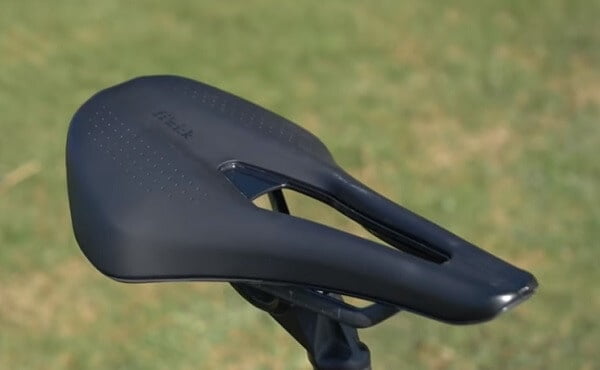
Image: Saddle with cut out
Frequently Asked Questions
Q1. Can a bike saddle be too wide?
Ans.: Yes, it can. Bike saddles must have just the right amount of width. Too narrow and there isn’t enough sit bone support. Too wide and your thighs will rub against the saddle and cause chafing which is quite unpleasant.
Q2. Is more padding always better?
Ans.: Surprisingly, more padding is not always better. In fact, if you frequently take long rides, then it is better to have minimal padding. Too much padding will cause heating and it will bunch between your sit bones and cause discomfort. For short or casual use, there won’t be any problems with a lot of padding.
Q3. How do I stop getting a sore bum when cycling?
Ans.: The best prevention of saddle soreness is to get the right fit. Simply follow the instructions mentioned in this article for that. Other than this, there are a few other things you could do, such as:-
- Using a pair of good quality padded shorts with shammy pads inside. These are mainly used with road bike saddles.
- Applying chamois cream to the pad in your shorts and/or to your perineum before a ride. It might feel a bit weird at first but it works.
- Standing up on your bike every 10 to 15 minutes. This restores blood flow and rests your back.
- Getting a gender-specific saddle. Female riders might particularly benefit from this since their anatomy is different and most traditional saddles were designed for men.
- Building up slowly to longer ride times. Initially, you will most likely feel some soreness. But this is normal and you should let your body get used to the new saddle.
Q4. What angle should my bike saddle be?
Ans.: Ideally, the saddle should be parallel to the ground. A slight nose-up of 1-2 degrees should be fine depending on which feels better. However, if it is too far upwards, it will cause discomfort. On the other hand, having a nose-down setup will shift your weight to your arms and can lead to excess muscle tension.
Conclusion
The best advice we can give you is to go to a bike shop and let them guide you. Seriously, don’t compromise on the right saddle, otherwise, you will regret it. We may have listed a lot of details but it’s not all that complicated. Just try out a few saddles, see how each feels, and you will find the right one. Also, make sure to give some time for your body to adjust. Slight soreness in the first few rides is completely fine, as long as it doesn’t hurt too much.
